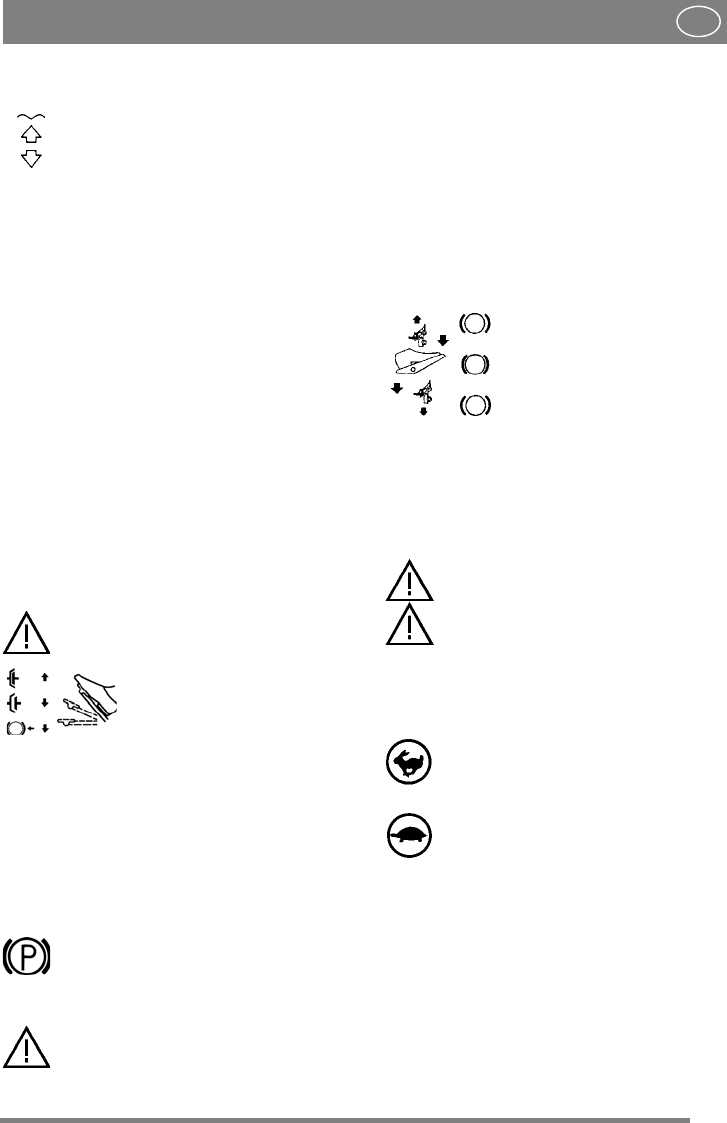
59
ENGLISH
EN
2.4.2 Implement lifter, hydraulic (4:M)
(4WD)
The hydraulic implement lifter only
works when the engine is running, and is
controlled with the switch (4:M).
The switch has the following three positions:
• Floating position. Press the front part of the
switch. The switch locks in the pressed position
and the implement is lowered until it reaches its
floating position.
Floating position means that the implement al-
ways rests with the same pressure against the
ground and can follow the ground’s contours.
Floating position should be used when working.
• Lifting. Press the rear part of the switch until
the implement is in its highest position (trans-
port position). Then release the switch and the
height is locked in transport position.
• Locking in transport position. The switch has
reverted to neutral position after lifting. The im-
plement is locked in transport position.
NOTE! The hydraulic implement lifter must be
in floating position in order for the power take-
off to be engaged.
NOTE! The power take-off cannot be engaged
when the parking brake is activated.
2.4.3 Clutch-parking brake (3:B)
Never press the pedal while driving.
There is a risk of overheating in the
power transmission.
The pedal (3:B) has the follow-
ing three positions:
• Released. The clutch is not activated. The park-
ing brake is not activated.
• Depressed halfway. Forward drive disengaged.
The parking brake is not activated.
• Pressed down. Forward drive disengaged. The
parking brake is fully activated but not locked.
2.4.4 Inhibitor, parking brake (3:A)
The inhibitor locks the “clutch-brake”
pedal in the depressed position. This func-
tion is used to lock the machine on slopes,
during transport, etc., when the engine is
not running.
The parking brake must always be re-
leased during operation.
Locking:
1. Depress the pedal (3:B) fully.
2. Move the inhibitor (3:A) to the right.
3. Release the pedal (3:B).
4. Release the inhibitor (3:A).
Unlocking:
Press and release the pedal (3:B).
2.4.5 Driving-service brake (3:F)
The pedal (3:F) determines the gearing ratio be-
tween the engine and the drive wheels (= the
speed). When the pedal is released, the service
brake is activated.
1. Press the pedal forward –
the machine moves forward.
2. No load on the pedal – the ma-
chine is stationary.
3. Press the pedal backward –
the machine reverses.
4. Reduce the pressure on the
pedal – the machine brakes.
2.4.6 Steering wheel (3:D)
The height of the steering wheel is infinitely ad-
justable. Undo the adjustment knob (3:E) on the
steering column and raise or lower the steering
wheel to the desired position. Tighten.
Do not adjust the steering wheel during
operation.
Never turn the steering wheel when the
machine is stationary with a lowered
implement. There is a risk of abnormal
loads on the servo and steering mecha-
nisms.
2.4.7 Throttle control (4,5:G)
Control for setting the engine’s revs.
1. Full throttle – when the machine is in
operation, full throttle should always be
used.
2. Idling.
2.4.8 Headlight (4,5:H)
Pull-type control for turning the headlights on and
off.


















